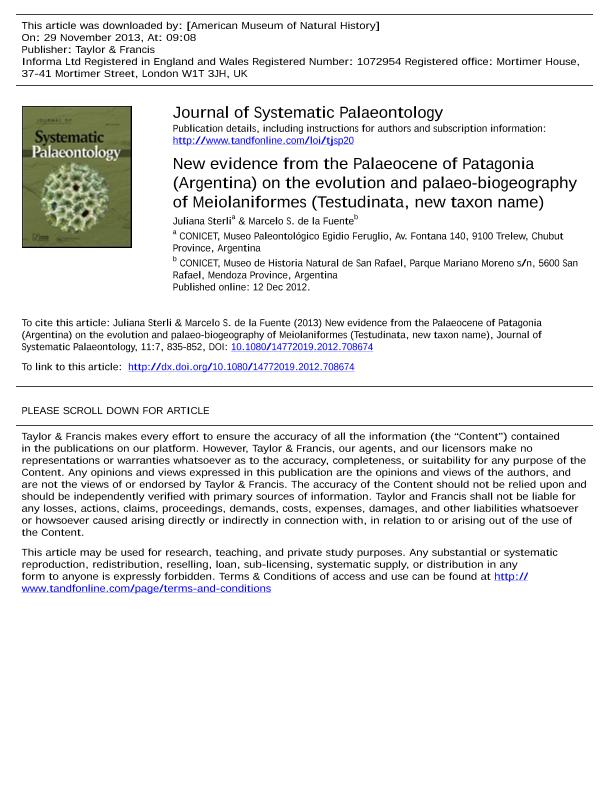Artículo
New evidence from the palaeocene of patagonia (Argentina) on the evolution and palaeo-biogeography of meiolaniformes (Testudinata, new taxon name)
Fecha de publicación:
12/12/2013
Editorial:
Taylor & Francis
Revista:
Journal of Systematic Palaeontology
ISSN:
1477-2019
Idioma:
Inglés
Tipo de recurso:
Artículo publicado
Clasificación temática:
Resumen
Peligrochelys walshae gen. et sp. nov. is a new stem turtle closely related to the clade Meiolaniidae found in the Palaeocene levels of the Salamanca Formation (Maastrichtian-Danian) of central Patagonia, Chubut Province, Argentina. A phylogenetic analysis shows that Peligrochelys walshae forms a monophyletic group with Mongolochelys efremovi, a clade that, in return, is the sister group of a clade formed by Patagoniaemys gasparinae, Otwayemys cunicularius, Kallokibotion bajazidi and Meiolaniidae. Meiolaniidae is recovered deeply nested in a monophyletic group (Meiolaniformes, newtaxon name) dominated by Gondwanan taxa (e.g. Chubutemys copelloi, Patagoniaemys gasparinae, Otwayemys cunicularius and Peligrochelys walshae), that also includes some notable Laurasian representatives (Mongolochelys efremovi and Kallokibotion bajazidi). The biogeographic scenario presented here supports the hypothesis that this group of turtles may have originated as early as the Early Cretaceous in the South American part of Gondwana. The long ghost lineage that extends below this clade suggests that it may have originated any time between the Early Jurassic and the Early Cretaceous, implying a Pangaean or Gondwanan origin for the clade, respectively. The phylogenetic scenario presented here shows that at least two lineages (Peligrochelys walshae and Meiolaniidae) of Meiolaniformes survived the K-P boundary extinction. Another interesting characteristic of meiolaniform turtles in the fossil record is their frequent association with another clade of strictly Gondwanan distribution, the pleurodiran clade Chelidae. This association is typically found in outcrops from the Early Cretaceous to the Eocene in central Patagonia, and in the Early Cretaceous and from the Miocene to the Pleistocene in Australia.
Archivos asociados
Licencia
Identificadores
Colecciones
Articulos(CCT - MENDOZA)
Articulos de CTRO.CIENTIFICO TECNOL.CONICET - MENDOZA
Articulos de CTRO.CIENTIFICO TECNOL.CONICET - MENDOZA
Articulos(CCT-CENPAT)
Articulos de CTRO.CIENTIFICO TECNOL.CONICET - CENPAT
Articulos de CTRO.CIENTIFICO TECNOL.CONICET - CENPAT
Articulos(IANIGLA)
Articulos de INST. ARG. DE NIVOLOGIA, GLACIOLOGIA Y CS. AMBIENT
Articulos de INST. ARG. DE NIVOLOGIA, GLACIOLOGIA Y CS. AMBIENT
Citación
Sterli, Juliana; de la Fuente, Marcelo Saul; New evidence from the palaeocene of patagonia (Argentina) on the evolution and palaeo-biogeography of meiolaniformes (Testudinata, new taxon name); Taylor & Francis; Journal of Systematic Palaeontology; 11; 7; 12-12-2013; 835-852
Compartir
Altmétricas




